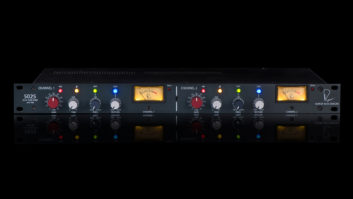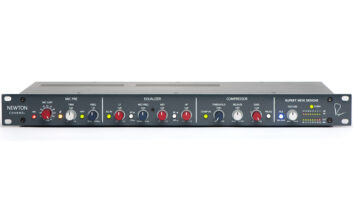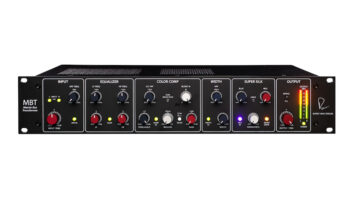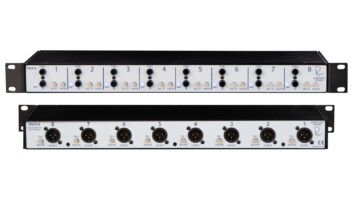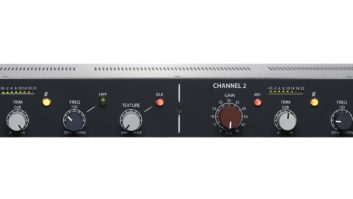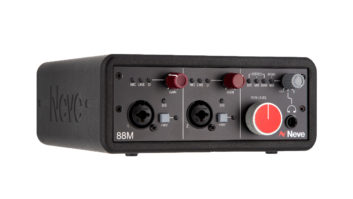The 5012 Duo Mic Pre belongs to Rupert Neve Designs’ new line of affordable, all-analog signal processors dubbed The Portico Series. Products in the series are designed to work either independently or be interconnected to form a larger system.
The dual-channel, solid-state 5012 features Mr. Rupert Neve’s new input and output transformers and a decidedly split personality. A defeatable Silk circuit, when activated, transforms the otherwise modern-sounding 5012 into a preamp with a classic sonic signature. And both timbres — modern and classic — sound great.
RACK ‘EM UP
The 5012 is a 1U, half-rack-size module with integral rubber feet for tabletop placement. Alternatively, single units or pairs can be rackmounted using an optional kit. Multiple units can purportedly be powered from a car battery without degrading performance.
Aside from a switch that activates Silk circuitry for both channels at once, all front panel controls, meters and indicators are duplicated on each independent channel. A rotary switch provides 0 to 66 dB of mic gain in 6dB steps. A continuously variable rotary trim control gives up to 6 dB of gain boost or cut for fine adjustments or riding gain. A highpass filter switch kicks in a 12dB-per-octave filter, the corner frequency for which can be continuously adjusted from 20 to 250 Hz with another rotary control. Other front panel switches include those for +48V phantom power, polarity reversal, muting the main outputs and sending signal to bus outputs. Eight-segment, multicolored LED ladders provide output metering for each channel.
All I/Os are on the rear panel. Mic inputs and main outputs are on balanced XLRs. Each channel also sports two unbalanced, high-impedance bus outputs on ¼-inch phone jacks. As more Portico Series products are released, users can connect them together via bus I/O jacks in various configurations to build an expandable, modular recording and mixing system. The two bus jacks for each channel are normaled together, allowing one to be used as an input and the other as an output so that multiple units may be daisy-chained (for busing several tracks to a common compressor, for example). Rounding out the rear panel are a power switch and a DC input jack for the external power adaptor.
The 5012’s specs are great. The main outputs’ frequency response is down only 3 dB at 160 kHz. Equivalent input noise is stated to be a quiet -128 dBu. Interchannel crosstalk is better than -90 dB at 15 kHz. Maximum output level is +25 dBu. The 5012 can take +26dBu input level at unity gain without a pad, inviting use as a line-level signal processor.
GOT SILK?
Recording a mellow electric guitar solo with a Royer R-121 ribbon mic and the 5012, the sound was very accurate but a little too clinical with the Silk circuit switched out. Switching in Silk provided a striking change in character, broadening the midrange frequencies, softening highs and adding a hefty helping of pleasing harmonics. The result was a lush, warm, golden tone that sounded downright phenomenal. I also used the 5012 as a line device to warm up a previously recorded electric guitar track that was edgy and thin-sounding. The Silk setting smoothed glassy highs and added pleasing girth to the track. Nice!
Some tracks sounded best with Silk switched out. A strummed Taylor XXX-MS acoustic guitar (miked with a spaced pair of B&K 4011s) on a country production called for a pristine recording. With Silk switched out, the stereo track had a wonderfully detailed top, clear mids and a tight bottom. Depth, nuance and stereo spread were outstanding. In a subsequent A/B test pitting the 5012 against my Millennia HV-3D — recording a Santa Cruz Orchestra Model acoustic guitar with B&K 4011s — the Millennia sounded yet a little more sparkly and open, providing a slightly more balanced tone overall. But the 5012 still sounded fantastic.
I also generally preferred to have Silk switched out when recording lead and background vocal tracks on country and pop productions. Silk produced a meaty, rich sound, but switching it out lent greater clarity, depth and detail to vocal tracks. While Silk sounded cool when tracking grittier rock vocals, the additional harmonic distortion that was produced would sometimes become overbearing at mixdown after additional compression was applied to the track.
Because the 5012 lacks DI inputs, I recorded an electric bass by going into an Aguilar DB 900 DI box before adding the 5012. I liked both 5012 settings — Silk switched in and out — equally well for this application. Silk provided a more pillowy and velvety tone, while disabling Silk lent greater depth and detail and a “drier,” yet still very big sound. It was great to have two distinctly different timbres from which to choose.
FEATURES + PRICE = BARGAIN
My complaints about the 5012 are very few. The meters are difficult to read when not viewed at eye level, there is no front panel power indicator and I wish that Silk could be independently engaged for each channel. However, the differences in tone that are provided when toggling Silk in and out of circuit are quite dramatic and double the usefulness of this very flattering preamp. At $1,795 list, the 5012 Duo Mic Pre is a bargain.
Rupert Neve Designs, 512/847-3013, www.rupertneve.com.
Mix contributing editor Michael Cooper is the owner of Michael Cooper Recording, located in beautiful Sisters, Ore.
